The question, "How long does a tire last?" tends to be followed by several others like, “What causes a tire to wear? When should tires be replaced? What can be done to make tires last longer?” Fortunately, we can help provide clarity around these questions.
There is no exact answer to how long a particular tire will last, but there are things a driver can do to get the most out of their tire investment and avoid driving on unsafe tires. On average, people drive between 12,000 to 15,000 miles a year, which means the average good quality all-season tire will last somewhere between three and five years, depending on maintenance, driving style and conditions, etc.
The National Highway Traffic Safety Association (NHTSA) states a driver is three times more likely to be involved in a crash caused by poor tire condition. Safer is smarter when it comes to the health of tires, so if there is ever a question on tread wear or age, have the tires checked.
Multiple factors play a role in how long a tire may remain in service. Miles driven, road conditions, driving style, maintenance and age all affect how long a tire lasts.
Worn vs. Aged
Tires naturally wear the more they are driven and worn out tires provide reduced traction compared to those with adequate tread, especially in adverse weather conditions. Most drivers understand worn out tires (remaining tread depth at or below 2/32”) should be removed from service.
Many drivers are not aware that minimally used tires, like the ones on recreational vehicles, collectible cars, or even spare tires, tend to experience aging instead of wearing, due to a lack of driving. An aged tire has a substantial amount of tread; however, the structural integrity of the tire is weaker because the tire needs to be driven for the chemicals in the rubber to remain effective.
Curbs, Potholes, and Other Hazards
Hitting curbs or driving on roads in poor condition (potholes, broken pavement, poorly graded railroad crossings, unpaved roads, etc.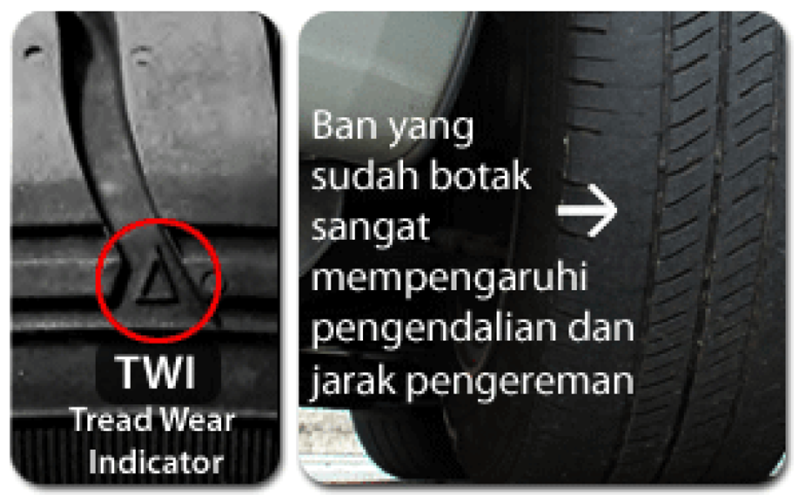 ) can cause misalignment, and suspension damage that affects tire wear. If your daily drive includes these challenges, be sure to schedule annual suspension, alignment and tire checks.
) can cause misalignment, and suspension damage that affects tire wear. If your daily drive includes these challenges, be sure to schedule annual suspension, alignment and tire checks.
Weather Conditions
Driving in poor weather conditions like ice, snow, and rain can cause tires to wear quicker because they must work harder to maintain traction. Purchasing tires that are specially engineered to perform in specific weather conditions can provide drivers with an extra measure of traction and control (meaning greater safety) while delivering good treadwear.
Bridgestone offers different types of tires designed to keep you and your car safe during any weather or road condition. For example, Bridgestone's Blizzak tire series is built to perform in harsh winter weather conditions providing durable traction on snowy and icy roads, and the Dueler tire series is one of several that offer a secure grip on wet road conditions for areas that experience heavy rain.
Poor Driving Habits
Poor driving habits like hard cornering, quick acceleration, and sudden braking can increase the stress on tires tremendously, causing them to wear rapidly. Drivers can extend the life of their tires significantly by avoiding aggressive driving.
Drivers can extend the life of their tires significantly by avoiding aggressive driving.
Neglected Maintenance
It is important to regularly have tires checked for damage, to maintain air pressure levels, and to keep tires aligned and rotated. Without proper maintenance, tire life can be reduced by as much as half - even more, in some cases.
If the below signs are evident with your tires, it may be time to have them replaced.
Low Tread Depth
Tread loss is a significant sign a tire needs to be replaced. Low tread is a sign driver can physically see happening on their tire. Depending on the part of the tire that is wearing, there may be other problems with the vehicle.
Pronounced inner or outer shoulder wear: tires are misaligned
Edge of the shoulder wear: tires are under-inflated, need to be rotated or both.
Center wear: tires may be overinflated or have been subjected to extremely hard acceleration.
Cupped wear: the vehicle is experiencing suspension problems
All tires have tread wear indicators built-in, but if the tread looks low take time to do the penny test on the tires.
Rough Drive
If you’re experiencing a vibration (particularly if it just started), or high (and increasing) levels of tire noise it may be a sign your tires are out of balance, not wearing properly or have a structural issue. In some cases, this may affect safety, so have your tires checked by a qualified professional asap.
DOT Number
The U.S. Department of Transportation (DOT) number on the tire’s sidewall is another way to help keep track of when they need to be replaced. It’s easy to identify - look for the letters “DOT” followed by eleven or twelve letters and numbers. On tires made after the year 2000 the final four digits signify the week and year of manufacture. So, a tire with “3618” would have been made in the 36th week or 2018. A tire that has a 3-digit week-and-year code means the tire was made before the year 2000 and should be replaced due to age.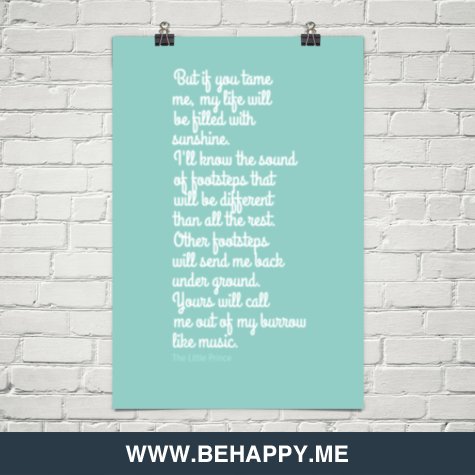
Bridgestone recommends that its Bridgestone or Firestone brand tires be removed from service after ten years regardless of their remaining tread depth. They also recommend periodic inspections by a qualified technician for damage such as punctures, impact damage, signs of improper inflation or overloading, or other conditions resulting from the use or misuse of the tire.
Tires are both one of the largest maintenance expenses a vehicle owner is likely to face, and one of the most critical in terms of driving safety and performance. For both reasons it’s important to care for them properly. Bottom line: good maintenance and driving habits help keep drivers safe, and it saves them money by extending tire life.
Easy Does It
Tire life can be reduced by as much as half when they’re subjected to a lot of hard braking and aggressive acceleration from a standstill. Avoiding tailgating to reduce the need for frequent hard braking will increase tire life. Easing into the throttle when pulling away from a stop reduces strain on the tires and improves wear. Slowing before sharp corners also reduces stress on tires, as does avoiding potholes and broken pavement when possible. If you’re interested in spending less on tires, following these steps can help.
Easing into the throttle when pulling away from a stop reduces strain on the tires and improves wear. Slowing before sharp corners also reduces stress on tires, as does avoiding potholes and broken pavement when possible. If you’re interested in spending less on tires, following these steps can help.
Regular Maintenance
Another way to extend tire life is to keep up with the proper maintenance of a vehicle and its tires. A couple of things you can do yourself are to check the air pressure and tread depth. You should have a qualified technician periodically check their balance and alignment and be sure to have tires rotated at regular intervals. maintenance is essential for your tires to perform their best and last their longest.
It may be tentative, but tires do have an expiration date. There is a general consensus that most tires should be inspected, if not replaced, at about six years and should be absolutely be swapped out after 10 years, regardless of how much tread they have left.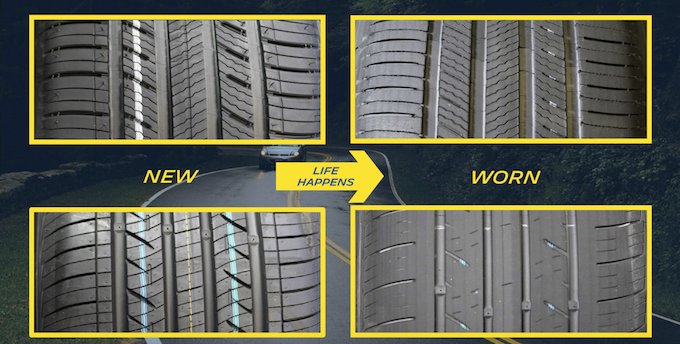 How do you know how old your tires are? There’s a code on the sidewall that you can read about here. Wear is a far more straightforward consideration: Tiremakers and safety advocates say a tire is worn out when its tread depth reaches 2/32 of an inch. That’s all fine, but what most car owners want to know is how long to expect a set of new tires to last before they need to be replaced.
How do you know how old your tires are? There’s a code on the sidewall that you can read about here. Wear is a far more straightforward consideration: Tiremakers and safety advocates say a tire is worn out when its tread depth reaches 2/32 of an inch. That’s all fine, but what most car owners want to know is how long to expect a set of new tires to last before they need to be replaced.
“I wish it were simple to say how long each tire might last, but tires are different,” said Dan Zielinski, a spokesman for the U.S. Tire Manufacturers Association (USTMA). “Some tire manufacturers offer a warranty as high as 80,000 miles or more, reflecting confidence in that particular product’s longevity based on its engineering, technology, and design. Other tires may be built to provide 30,000 miles of service.” Or less; some high-performance tires on cars driven aggressively will be worn to the 2/32-inch point without ever seeing 15,000 miles, but those are extreme cases.
The average American drives between 14,000 and 15,000 miles a year, according to data from the Federal Highway Administration. Zielinski said that, if you’re kind to your tires—that is, you aren’t constantly peeling out at stoplights and you properly maintain them—most new tires on the market today will last about 60,000 miles. For what it’s worth, the USTMA did a review of several thousand recently scrapped tires and found that most were three to four years old. There was no way of telling how many miles were on those tires, but it’s easy enough to multiply four years by 15,000 miles annually to confirm the rough approximation of tire durability.
Zielinski said that, if you’re kind to your tires—that is, you aren’t constantly peeling out at stoplights and you properly maintain them—most new tires on the market today will last about 60,000 miles. For what it’s worth, the USTMA did a review of several thousand recently scrapped tires and found that most were three to four years old. There was no way of telling how many miles were on those tires, but it’s easy enough to multiply four years by 15,000 miles annually to confirm the rough approximation of tire durability.
If you want to figure out how soon you’ll wear out the tires on your car, Zielinski said it would be a good idea to start by determining how many miles you drive each year. Divide the number of miles on the odometer by how many years you’ve owned the car (starting, obviously, from when you first got the car and accounting for any mileage it had on it at that time). Then you can compare that with any advertised warranty on the make and model of the tires and figure out how many years of service to expect. If you live where winter tires are advisable and swap those onto the car for some months of the year, your regular tires will get less use and will endure for a longer period of time, but remember the caveats about tire age.
If you live where winter tires are advisable and swap those onto the car for some months of the year, your regular tires will get less use and will endure for a longer period of time, but remember the caveats about tire age.
Zielinski also noted that if you hit the wear bars at 50,000 miles on a set of tires with a 60,000-mile warranty, for example, tiremakers that offer such coverage will typically prorate the price of a new set. In this example, you could expect a discount on the new set equal to one-sixth their price, or about 17 percent. You might not get it, though, if you decide to change brands.
Kypros/Getty Images
In general, the best way to preserve the life of your tires, and keep yourself and your passengers safe, is to maintain them properly. Here are some tire basics and maintenance tips:
Tread
A tire is considered unsafe, and should be changed, once its tread is worn down to 2/32 of an inch, according to the National Highway Traffic Safety Administration (NHTSA).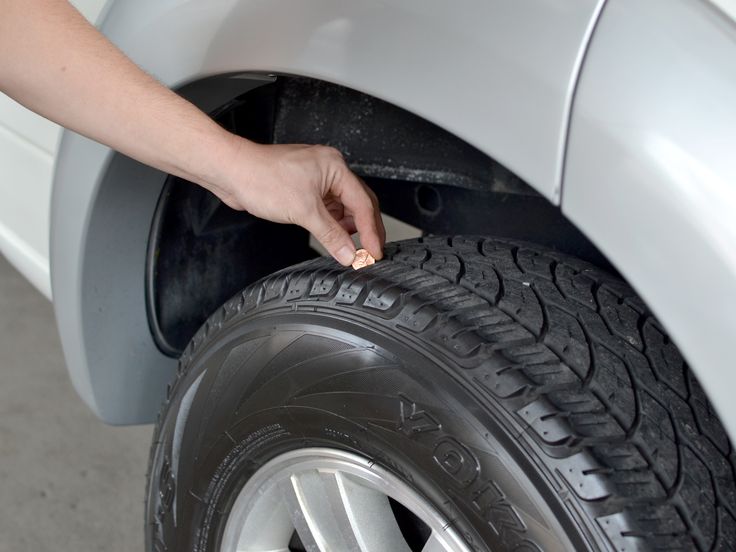 Many tires have tread-wear indicators, which are little bars in the tread that show when the tire is worn down to replacement level. These will start making noise to alert the driver that they need attention. You can also use a penny: NHTSA recommends putting the penny in the tread with Abraham Lincoln’s head upside down and facing toward you. If you can see the top of Abe’s head, it’s time for new tires.
Many tires have tread-wear indicators, which are little bars in the tread that show when the tire is worn down to replacement level. These will start making noise to alert the driver that they need attention. You can also use a penny: NHTSA recommends putting the penny in the tread with Abraham Lincoln’s head upside down and facing toward you. If you can see the top of Abe’s head, it’s time for new tires.
Pressure
To ensure even wear, tiremakers and auto companies recommend that vehicle owners check their tire pressures monthly. The pressure should be at the vehicle manufacturer’s recommended level, which is usually found in the car or truck’s doorjamb or in the owner’s manual. One quick and easy way to check tire pressure is with a handheld tire-pressure gauge, which you can find starting around $10 at an auto-parts store. Tire shops will often check the pressure for you. Some gas stations have digital readouts as part of their air pumps; these are not always accurate, though. It’s best to check the pressures when the tires are cold, meaning that they have not been driven on for several hours. So you’re better off checking them at home after the car has been parked overnight.
It’s best to check the pressures when the tires are cold, meaning that they have not been driven on for several hours. So you’re better off checking them at home after the car has been parked overnight.
Balance and Alignment
Tires need to be round, and the tire/wheel combination needs to be balanced. Tire shops and mechanics will use a balance machine, which spins the wheel to see where high and low spots are and detects any imbalance. The tire shop will then add weights, which are hammered onto the wheel, to balance them. These shops can also make make sure your wheels are aligned to keep the car tracking straight, which also reduces tire wear.
Rotation
Rotating your tires can help prolong their lives. For front-wheel-drive vehicles, the tires in the front will wear more quickly and can be swapped with the rear ones. The inverse is true for rear-wheel-drive cars and trucks. All-wheel-drive models, too, may need rotation. Most owner’s manuals contain a recommended pattern for rotating tires to spread the wear evenly. The USTMA recommends tires be rotated every 5000 to 8000 miles.
For front-wheel-drive vehicles, the tires in the front will wear more quickly and can be swapped with the rear ones. The inverse is true for rear-wheel-drive cars and trucks. All-wheel-drive models, too, may need rotation. Most owner’s manuals contain a recommended pattern for rotating tires to spread the wear evenly. The USTMA recommends tires be rotated every 5000 to 8000 miles.
This content is imported from OpenWeb. You may be able to find the same content in another format, or you may be able to find more information, at their web site.
If you drive long enough, you will eventually need to change your tires. It's important to know when it's time to make this change, as having good quality tires can help you avoid crashes and maintain control of your car.
According to TireRack, there is no set calendar age that indicates it's time to change your tires. Environmental conditions such as road salt and salty air, extreme temperatures and exposure to direct sunlight can cause your tire to wear faster, no matter how old it is. In general, if your tires are over six years old, you may need to replace them. If they are over 10 years old, the chances that the rubber has decomposed are even higher. nine0003
Environmental conditions such as road salt and salty air, extreme temperatures and exposure to direct sunlight can cause your tire to wear faster, no matter how old it is. In general, if your tires are over six years old, you may need to replace them. If they are over 10 years old, the chances that the rubber has decomposed are even higher. nine0003
When you buy new tires, you will see that they are rated for a certain number of miles. It depends on the brand. Autos.com reports that if you don't have tires that wear long or are approved for the long haul, you'll likely need to replace them after about 40,000 miles. nine0003
If your car does not drive as well as it used to, this change may indicate that your tires need to be replaced. Trouble driving on wet pavement and difficulty maintaining traction in corners can be signs of tire wear.
A bulge or protrusion on the sidewall or vertical edge of the tire may indicate a weak spot. Over time, this stain can cause a tire to burst, so it's important to have it checked right away. Cracks can also indicate weakness. nine0003
Poor alignment can cause your vehicle to vibrate, but uneven tire wear can be another cause. Also, an internal problem in the tire can cause this behavior, so it's important to check the tires and possibly replace them if this occurs.
Many new cars have tire pressure monitoring systems to alert you when one or more tires are under-inflated. If your car does not have this feature, it is important to check your tire pressure regularly. Tires should be inflated to the pressure recommended by the manufacturer. If you regularly drive with one or more tires under-inflated, you may need to buy new tires sooner rather than later. Under-inflated tires place excessive stress on the tire sidewalls, causing them to wear faster. nine0003
Under-inflated tires place excessive stress on the tire sidewalls, causing them to wear faster. nine0003
Tire tread must have a certain depth to ensure proper traction. If the tread depth is too shallow, your car will not handle the road well. According to a commentary published in the journal Traffic Injury Prevention, most states require 1/16 inch tread depth. However, if the tread depth is less than 1/8 inch, traction is significantly reduced. Most tires have wear bars that open when the tread is less than 1/16 inch. nine0003
If you are not sure if the tread has wear strips, you can use the "penny test" to check the tread. Here's how to do it:
Checking the condition of your tires and changing them as needed is part of being a safe driver. Having good tires on your car means you'll be able to drive better and avoid accidents. If you notice signs of wear or damage to your tires, it's time to buy new tires.
Having good tires on your car means you'll be able to drive better and avoid accidents. If you notice signs of wear or damage to your tires, it's time to buy new tires.
Konstantin Ishchenko
an experienced car enthusiast
The hardest hit on the budget of a motorist is when you have to buy both summer and winter sets of tires within one year. nine0003
For example, the popular Nissan Qashqai is equipped with 225/45 R19 tires in the maximum configuration, a set of the middle price category will cost about 50,000 RUR.
But there is an option to save money and buy used tires. This article will tell you how to safely buy used tires and when you shouldn't.
Suppose that the tires are worn out, worn out or the season has changed. We wrote in detail about how to assess the condition of tires and understand when they need to be changed in a separate instruction. Before you start looking for tires, it is important to be able to read their parameters. The most important in this situation are the size, manufacturer and model of the tire. nine0003
We wrote in detail about how to assess the condition of tires and understand when they need to be changed in a separate instruction. Before you start looking for tires, it is important to be able to read their parameters. The most important in this situation are the size, manufacturer and model of the tire. nine0003
If the task is to buy a set of four tires, then it is important to respect the size. If you damaged one tire, you will have to look for exactly the same one: two wheels of the same axle must have tires with the same tread pattern, and this is possible only in the case of tires of the same model.
/save/koleso-hack/
How to save money on buying car tires and wheels?
Tire parameters important to look for: width, profile height and rim diameter Tire manufacturer and model According to Avtostat, an average car in Russia drives 17,500 km a year. Let's take the average wear resistance of tires according to the Treadwear index - 320 and calculate how long a new set of summer tires could theoretically last.
Every 100 index units is 12,500 km, which means tires are rated for 40,000 km. Assuming that the summer kit is used for 6 months out of 12, the mileage for six months is 8750 km, and the kit is enough for 4.5 seasons.
If the annual mileage is 30,000 km, then the summer kit should wear out in 2.7 seasons. But I have not met people who change tires in the middle of the season: either they change them in the spring, or they drive them until autumn. nine0003
Judging by Yandex Market, the average popular tire 205/55 R16 costs 5500 R, which means that the set is 22 000 R. Let's round up 2.7 to three full seasons. One season costs Rs. pay more than 14,000 R. How to evaluate the tread depth on a used tire, we will tell a little later. nine0003
/top-economic-cars/
11 economical cars for daily driving
These are very average values, but still usable. There is no perfect formula, operating conditions and driving style are very different.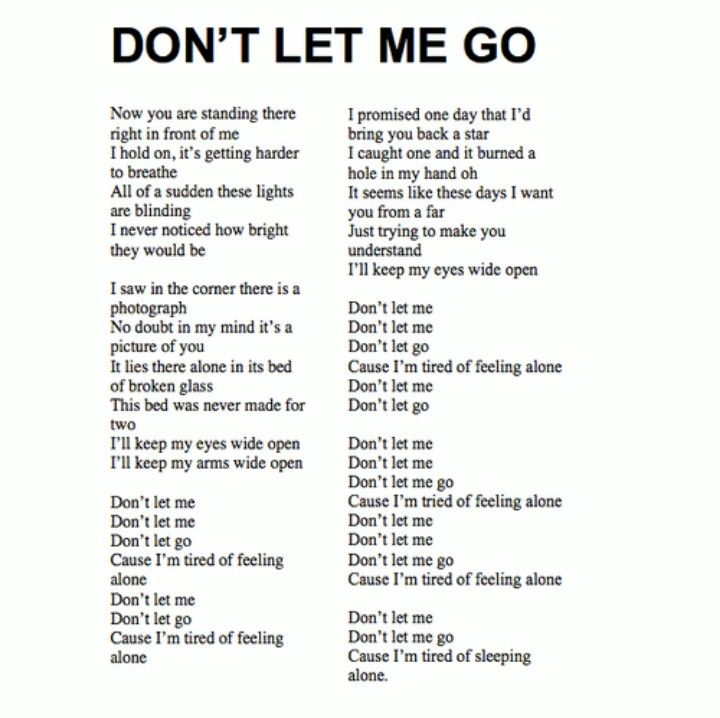
Buying used tires will allow you not to get into a loan if a new set is too expensive. Or it will help those who know for sure that at the end of the season they will change the car: there is no point in buying new tires for the next driver. However, the theoretical calculation does not take into account your travel time for the next purchase and the risks of buying a bad kit. If you plan to drive a car for at least two years, buy new tires. nine0003 Velcro on stamped disc. A set of tires and wheels - 3000 R. I took it to change the car into it for the duration of a long body repair. It was a pity for me to leave the car on the expensive original casting. I had to spend two weeks searching, look through hundreds of ads and once go to the other end of the city. When the wheels are no longer needed, I plan to sell for 6000 R
At first glance, selling tires is illogical. Tires need to be worn out completely and then disposed of, but the market for used rubber is huge. It has several types of sellers with very different offers. nine0003
It has several types of sellers with very different offers. nine0003
Companies that sell used tires from Europe and Japan. Despite the ban on the import of used rubber, which has been in effect in the Eurasian Customs Union since January 1, 2010, this business is booming. The main thing is to prove that tires are not hazardous waste and they are not imported for recycling. Therefore, on Avito and various sites, many offices offer used tires of various brands, sizes and models.
| Benefits | Disadvantages |
|---|---|
| Huge selection of summer tires Advice available, professionals know their product Usually there is a tire service on site Safer remote purchase. Many trade by bank transfer as a full-fledged online store Tire warranty until the first tire fitting, a defective tire will be replaced with a good one or money will be returned | nine0141 There is almost no choice of winter tires: no studded and little friction - Velcro.
Here are some of the benefits of a specialist shop that sells used tires:
But there are also disadvantages:
 Everything is like in the market in the bad sense of the word.
Everything is like in the market in the bad sense of the word. Dealers and tire shops. They differ from the first ones in scale - they are much smaller, and also in that they trade at best on the scale of one city. Often the base for such activities is a tire shop. They buy cheaply at Avito or from tire fitting clients, sell more expensively at Avito or other tire fitting clients. nine0003
There are also not very pleasant scenarios: an unscrupulous tire fitting worker offers to dispose of a completely normal set of tires “out of friendship” and gets it for free. For another client, the same kit “very much nothing, two seasons will definitely pass” costs 15,000 rubles.
/save/garage-hack/
A typical tire shop that sells rubber for emergency replacement of a damaged tire.
 The choice is small, storage is not according to the rules: direct sunlight damages tires. But there are situations when there is no choice
The choice is small, storage is not according to the rules: direct sunlight damages tires. But there are situations when there is no choice Individuals who sell unwanted tires for a variety of reasons. Here are the main ones:
| Advantages of | Disadvantages |
|---|---|
| You can search for tires by car make and model, not just size With a bit of luck, you can make a super bargain | You will have to choose among ads for a long time and carefully Many do not know what they are selling (errors in names, sizes and tire models are the norm) A rare seller agrees to tire fitting in his presence, everything will have to be checked by himself and by hand Many scammers: they can offer to leave an advance payment and disappear or send an erased kit instead of what is in the ad No warranty on tires |
Here are some of the benefits of buying used tires from individuals:
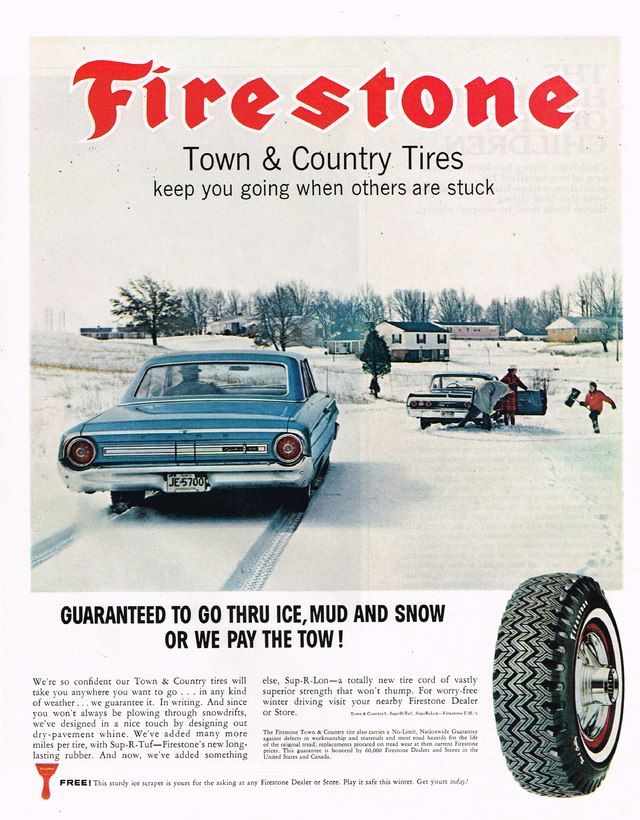
But there are also disadvantages:
Universal ad platforms: Avito, Yula and others. Here is the largest selection of used tires. Both private traders and professionals sell. Despite the convenient application and filters, it takes a lot of time to search. Don't expect every seller to list the model correctly. Bridgestone Potenza can become just "Bridge Stone" - and this is not the worst option. nine0003
Here is the largest selection of used tires. Both private traders and professionals sell. Despite the convenient application and filters, it takes a lot of time to search. Don't expect every seller to list the model correctly. Bridgestone Potenza can become just "Bridge Stone" - and this is not the worst option. nine0003
You will have to scroll through a huge number of ads with completely worn-out tires that are only suitable for recycling. Unfortunately, no filters will save you from this. Looking for tires on Avito is like looking for a treasure: you have to dig a lot, and no one guarantees a reward, but some are lucky.
/avito-fraud/
"Avito": how to avoid scammers
Adjust the filter by size - so you will have more chances to find the tires you need You can no longer drive on such tires: they are worn out to the limit marks, this can be seen even in the photo. Plus, the sidewalls are very worn out. But the seller still thinks that he can get 3000 R for them Websites for car sales announcements: "Avto-ru" and "Drom". There are few private ads here, mainly specialized stores operate on such sites.
There are few private ads here, mainly specialized stores operate on such sites.
Droma has the largest selection of used wheels and tires from Japan in the country. Drome offers a good customer protection service and acts as a guarantor of purchase: if they send you worn or damaged tires, the site will return the money. If everything is fine, they will be transferred to the seller.
At the time of writing the article on Avto-ru, there were only five private ads for the sale of tires of the common size 205/50 R17 throughout Russia. It makes no sense to look for tires from private traders on this site. Source: Avto-ruCar club sites: forums, chat rooms, Drive-2 — places where representatives of car clubs communicate. Sometimes it can be difficult to find the site itself. This can be a group on Vkontakte, a chat on Telegram or WhatsApp.
There are fewer offers here, but they are more interesting, more likely to find a good set. It is not customary to post completely junk for sale in communities or to greatly inflate the price: the ad will be discussed, criticized, or even deleted altogether.
But don't forget about safety. You should not buy something without verification or send the entire amount to a stranger in another city. It is usually customary to ask a friend of a teammate to go look at the kit and make sure that the tires are sent. Here, as a rule, you can place your ad on the purchase of the necessary tires and wait for responses. nine0003
There is a flea market on Drive-2. It is not very popular, but it is worth looking into it: there are filters separately for disks, wheels and tires, you can specify the dimensions.
/carservice/
How to save on the operation of the car
Special online stores and car disassembly. In most cases, such sellers open an official representative office on Avito, but some sites are also still working. They may have rare tires or a more interesting price. Large auto-dismantlers rarely sell tires - they mainly sell sets of wheels. The condition of the tires on the rims is most often mediocre: a car is not sent to scrap on good tires. nine0003
nine0003
Tire shops and car services. It's hard to find interesting deals on tires here, it's not their business. Tires in a tire shop are usually bought in emergency cases: when one or more tires are damaged, but you need to somehow drive a couple of weeks to pay.
Price. Before buying used tires, it is better to check the price of new tires of the right size. Tires from young Chinese brands are very cheap, and the market for used tires is overheated and overpriced. It is impossible to unequivocally answer which is better: a new tire from an unknown manufacturer or a used tire from a well-known brand. But it is necessary to compare, study reviews and weigh everything. nine0003 At first glance, an excellent offer. A set of fresh tires 215/55 R17 with 20% wear for 18,000 R. But the indicated balance of 6 mm is about 30% wear. The remaining tread of the new tire is 8 mm, the tread limiter bar has a height of 1. 6 mm. The tire is worn 2 mm. Usable tread depth: 8 mm − 1.6 mm = 6.4 mm. 2mm from 6.4mm is 31% wear. Source: Avito But then it turns out that the new ones are very inexpensive. The remaining 6 mm is two-thirds of the tire resource, which means that buying such a kit costs no more than 16,000 R. Source: Yandex Market
6 mm. The tire is worn 2 mm. Usable tread depth: 8 mm − 1.6 mm = 6.4 mm. 2mm from 6.4mm is 31% wear. Source: Avito But then it turns out that the new ones are very inexpensive. The remaining 6 mm is two-thirds of the tire resource, which means that buying such a kit costs no more than 16,000 R. Source: Yandex Market
Manufacturer, model, size, indices and other features. Be sure to check all the characteristics of the tires - everything that is indicated on the sidewall. The seller may not understand tires well or deliberately lie. Carefully inspect each tire. For example, you can accidentally buy a set of four tires, where three will be with runflat technology and one without it. If buying tires remotely, always ask for individual photos of each tire in full detail, or even better, a video.
Tire year. Among the ads of specialized stores, there are often tires that are more than 5 years old. Tires may have excellent tread residue, but it is better to refrain from such a purchase. The older the tire, the worse its properties and the greater the chance of hidden damage: cracks, delaminations and ruptures.
The older the tire, the worse its properties and the greater the chance of hidden damage: cracks, delaminations and ruptures.
/wtf/bezkoles/
How online tire stores deceive car owners
The tire release marking always looks like this: the first two digits are the week of production, the second two are the yearTread depth. It is not necessary to measure the residual depth “by eye”, it is better to buy a special device or use a caliper. The standard tread depth of new summer car tires is 7-8 mm, winter tires are 8-10 mm.
About tires that are long overdue for disposal, they wrote above: summer tires less than 4 mm or winter tires less than 5 mm should not be bought "for the season", it is not safe.
Digital Tread Depth Gauge is a simple and cheap instrument. It will help to accurately measure the residual tread depth and adjust the price of a set of tires. Source: Yandex Market Tread condition, damage and repairs. Don't buy tires with uneven tread wear. They will not be able to provide a complete drainage of water from the contact patch with the road, it is unsafe to ride on them. Severe cuts or even the absence of individual tread fragments will also be a reason to refuse a purchase. Without a specialist, you run the risk of buying a tire that you cannot use.
Don't buy tires with uneven tread wear. They will not be able to provide a complete drainage of water from the contact patch with the road, it is unsafe to ride on them. Severe cuts or even the absence of individual tread fragments will also be a reason to refuse a purchase. Without a specialist, you run the risk of buying a tire that you cannot use.
But do not be afraid of well-repaired punctures. Tires with patches on the inside of the tread part can be bought, this will not affect further operation. You should not buy tires on which punctures were repaired with a tourniquet. nine0003
/mini-jcw/
How much does it cost to own a Mini John Cooper Works
Obviously, this tire is no good: there is almost no tread, the studs are completely worn out. The central part is almost completely missing, and the sidewalls are less worn. Maybe the tire was pumped. Surprisingly, they also sell such Cracks and delaminations. Long longitudinal cracks, along the circumference of the tire on the sidewall or small cracks in the tread area - in any case, bad. Either such a tire was poorly stored, or it is very old. This is a particularly dangerous case, because such a tire can collapse while driving and cause a terrible accident. Cracks are not repaired, so you will have to refrain from buying. nine0003
Long longitudinal cracks, along the circumference of the tire on the sidewall or small cracks in the tread area - in any case, bad. Either such a tire was poorly stored, or it is very old. This is a particularly dangerous case, because such a tire can collapse while driving and cause a terrible accident. Cracks are not repaired, so you will have to refrain from buying. nine0003
Sidewall condition, damage and repairs. Hernias of any size, side cuts and patches on the side of the tire are good reasons to keep looking. You can't buy these tires.
Carefully inspect and feel the sidewalls of the tires. Unfortunately, not all defects can be found on a tire without a disk and without air inside. It will be ideal if you can mount tires on rims in a tire shop. Ask to balance the wheels and only then pay.
/guide/rezina/
How to choose tires for a car or crossover
If in doubt that the tires are intact, look for another option. Remember that it is the tires that connect your car and the road.
Remember that it is the tires that connect your car and the road.
Presence of spikes and their condition. It is not necessary to count every stud on a tire, it is difficult and time consuming. Just look at the tire: if it seems that there are about half of the studs on it or less, you do not need to buy a tire. Studded tires without studs won't get Velcro, so don't just look at the tread.
Studs on a tire that has already been driven for a couple of seasons look very different from new ones. They were worn off along the way, the seats were broken. In the background, you can see that the tire has already begun to lose studs. Even with sufficient tread, you can be left without spikes very quickly, it is better to look for another option Ads often offer used tires at an inflated price. We have made a special calculator that will help you calculate the fair value of tires, regardless of the manufacturer, technical parameters of tires and their number in the kit.
We have made a special calculator that will help you calculate the fair value of tires, regardless of the manufacturer, technical parameters of tires and their number in the kit.
